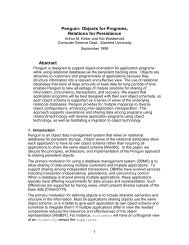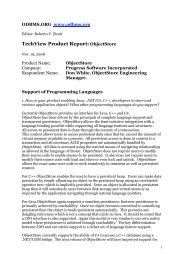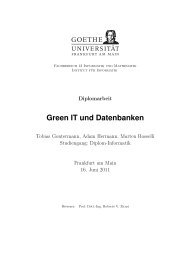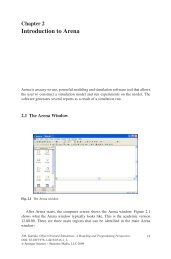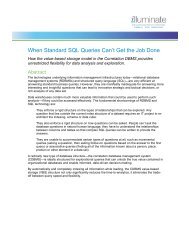Download Chapters 3-6 (.PDF) - ODBMS
Download Chapters 3-6 (.PDF) - ODBMS
Download Chapters 3-6 (.PDF) - ODBMS
You also want an ePaper? Increase the reach of your titles
YUMPU automatically turns print PDFs into web optimized ePapers that Google loves.
24 3. PATTERNS IN EVOLVING GRAPHS<br />
connected component (GCC) was formed. After that, the size of the 2nd NLCC seems to oscillate<br />
between 40 and 300, with growth periods followed by sudden drops (= absorptions into GCC).<br />
Observation 3.2 Oscillating NLCCs After the gelling point, the secondary and tertiary connected<br />
components remain of approximately constant size, with relatively small oscillations (relative<br />
to the size of the GCC).<br />
3.5 D-5: LPL: PRINCIPAL EIGENVALUE OVER TIME<br />
A very important measure of connectivity of a graph is its first eigenvalue 1 . We mentioned eigenvalues<br />
earlier under the Eigenvalue Power Law (Section 2.2), and we reserve a fuller discussion of<br />
eigenvalues and singular values for later (Section 14.1 and Section 14.2). Here, we focus on the<br />
principal (=maximum magnitude) eigenvalue λ1. This is an especially important measure of the<br />
connectivity of the graph, effectively determining the so-called epidemic threshold for a virus, as we<br />
discuss in Chapter 17. For the time being, the intuition behind the principal eigenvalue λ1 is that it<br />
roughly corresponds to the average degree. In fact, for the so-called homogeneous graphs (all nodes<br />
have the same degree), it is the average degree.<br />
McGlohon et al. [200, 201], studied the principal eigenvalue λ1 of the 0-1 adjacency matrix<br />
A of several datasets over time. As more nodes (and edges) are added to a graph, one would expect<br />
the connectivity to become better, and thus λ1 should grow. Should it grow linearly with the number<br />
of edges E? Super-linearly? As O(log E)?<br />
They notice that the principal eigenvalue seems to follow a power law with increasing number<br />
of edges E. The power-law fit is better after the gelling point (Observation 3.1).<br />
Observation 3.3 λ1 Power Law (LPL) In real graphs, the principal eigenvalue λ1(t) and the<br />
number of edges E(t) over time follow a power law with exponent less than 0.5. That is,<br />
λ1(t) ∝ E(t) α ,α≤ 0.5<br />
Fig.3.5 shows the corresponding plots for some networks, and the power-law exponents. Note<br />
that we fit the given lines after the gelling point, which is indicated by a vertical line for each dataset.<br />
Also note that the estimated slopes are less than 0.5, which is in agreement with graph theory: The<br />
most connected unweighted graph with N nodes would have E = N 2 edges, and eigenvalue λ1 = N;<br />
thus log λ1/ log E = log N/(2 log N) = 2, which means that 0.5 is an extreme value – see [11] for<br />
details.<br />
1 Reminder: for a square matrix A, the scalar-vector pair λ, u are called eigenvalue-eigenvector pair, if Au = λu.SeeSection 14.1.




